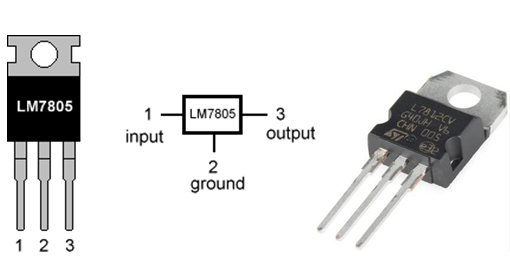Voltage Regulator
A voltage regulator is an essential electronic component used to maintain a stable output voltage regardless of fluctuations in input voltage or variations in load current. It ensures that sensitive components in electronic circuits receive a constant voltage, which is crucial for the reliable operation of devices. Voltage regulators are widely used in power supplies, charging circuits, and systems that require a steady and predictable voltage source for optimal performance.
There are two main types of voltage regulators: linear regulators and switching regulators. Linear regulators, such as the popular LM7805 series, provide a fixed output voltage by dissipating excess input voltage as heat. They are simple to use, inexpensive, and provide low noise, making them ideal for low-power, low-noise applications like audio equipment or analog circuits. However, they are less efficient, especially when there is a large difference between the input and output voltages, as much of the energy is lost as heat. This inefficiency can become problematic in high-power applications.
On the other hand, switching regulators (also called switch-mode power supplies, or SMPS) are more efficient than linear regulators, as they work by rapidly switching the input voltage on and off and then smoothing the resulting signal with an inductor and capacitor. This allows them to maintain a stable output voltage with less energy loss, making them ideal for high-power applications like computers, mobile devices, and industrial equipment. Switching regulators can step up (boost), step down (buck), or invert the input voltage, providing more versatility compared to linear regulators. However, they are more complex, generate higher electromagnetic interference (EMI), and require careful design to minimize noise and ensure stable operation.
In addition to these basic types, voltage regulators come in different forms to meet specific needs. Adjustable voltage regulators allow the user to set the desired output voltage with external resistors, while low dropout regulators (LDOs) are a subset of linear regulators that can operate with a small difference between the input and output voltage, making them ideal for battery-powered devices where efficiency and low voltage drop are crucial.
Overall, voltage regulators are indispensable in modern electronics, providing voltage stability and protection for sensitive components, improving efficiency, and ensuring the smooth operation of a wide range of devices. Whether in low-power circuits or high-performance systems, voltage regulators play a critical role in the functionality and reliability of electronic products.
There are two main types of voltage regulators: linear regulators and switching regulators. Linear regulators, such as the popular LM7805 series, provide a fixed output voltage by dissipating excess input voltage as heat. They are simple to use, inexpensive, and provide low noise, making them ideal for low-power, low-noise applications like audio equipment or analog circuits. However, they are less efficient, especially when there is a large difference between the input and output voltages, as much of the energy is lost as heat. This inefficiency can become problematic in high-power applications.
On the other hand, switching regulators (also called switch-mode power supplies, or SMPS) are more efficient than linear regulators, as they work by rapidly switching the input voltage on and off and then smoothing the resulting signal with an inductor and capacitor. This allows them to maintain a stable output voltage with less energy loss, making them ideal for high-power applications like computers, mobile devices, and industrial equipment. Switching regulators can step up (boost), step down (buck), or invert the input voltage, providing more versatility compared to linear regulators. However, they are more complex, generate higher electromagnetic interference (EMI), and require careful design to minimize noise and ensure stable operation.
In addition to these basic types, voltage regulators come in different forms to meet specific needs. Adjustable voltage regulators allow the user to set the desired output voltage with external resistors, while low dropout regulators (LDOs) are a subset of linear regulators that can operate with a small difference between the input and output voltage, making them ideal for battery-powered devices where efficiency and low voltage drop are crucial.
Overall, voltage regulators are indispensable in modern electronics, providing voltage stability and protection for sensitive components, improving efficiency, and ensuring the smooth operation of a wide range of devices. Whether in low-power circuits or high-performance systems, voltage regulators play a critical role in the functionality and reliability of electronic products.
